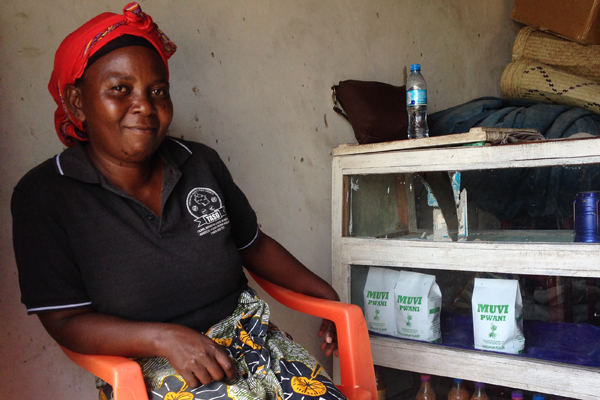Lilian Madelemo | February 5, 2018
Anna Macha sits in the shade of her shop in Kongo village, eastern Tanzania, when a woman approaches and asks for a kilogram of cassava flour. Mrs. Macha smiles as the customer sets the green and white package on one hip and walks away.
Mrs. Macha grows cassava on three hectares of farmland next to her village, about 70 kilometres north of Dar es Salaam. Along with some of her neighbours, she processes most of her cassava into flour and thinly-sliced fried crisps. She says the profits from selling these products are better than from selling raw cassava—and so is the feeling she gets from each sale.
She says proudly, “When people come to buy, I feel good. We grew it, we produced it, we packaged it, and people come to buy it.”
Mrs. Macha is one of 17 members of the Tupendane Tutapata farmers’ group. In addition to her family’s farm, she also helps grow cassava on a communal plot.
The farmers work together to chip the cassava, dry it in the sun, and then grind it into flour or fry it as crisps. Members take turns selling their products from the shop. They sell a one-kilogram bag of cassava flour sells for 1500 Tanzania shillings (US$0.66).
The same product can sell for twice that much at a supermarket in town, but Mrs. Macha says the group doesn’t have enough money to pay the transportation costs to reach those potential buyers.
Mrs. Macha and her fellow farmers have faced other challenges, including a pest known as inzi wa kijani, or green mite. Also, they want to borrow money from the bank to buy a tractor, but have so far been unable to get a loan.
To expand their business, the farmers want to grow more cassava. But the village population is increasing and there is no farmland available.
Despite these difficulties, Mrs. Macha says processing cassava has meant more profits for the farmers.
Mrs. Macha estimates that, in each harvest cycle, the farmers’ group spends about 200,000 Tanzanian shillings (US$89) per hectare on seeds, tools, maintenance, and packaging for their products. They earn about 1,000,000 shillings (US$443) per hectare, leaving them with 800,000 shillings (US$355). The farmers put some of this aside to pay for big expenses such as machinery, and divide the rest between them. Mrs. Macha and her neighbours harvest cassava twice per year.
The village of Masimba lies 200 kilometres further north, hidden in the lush, humid hills of Tanga Region. Behind a cluster of newly-built brick houses, leafy cassava reaches as high as the rooftops.
Ten years ago, families here were afraid for their future. Cassava mosaic disease had destroyed much of their staple crop. But now the community is thriving.
Mohamad Rajabo explains: “Before, when we were using local varieties, we were affected by cassava mosaic disease. If we had stayed with the local varieties, we could no longer grow cassava in this region. It was very serious.”
They decided to form a group called Wambato, which has 11 men and 14 women farmers. They switched to a disease-resistant cassava variety called Kiroba. The members built a small cassava processing plant in the village, where they cut the fresh tubers into chips and grind dried cassava into flour.
Mr. Rajabo says Kiroba produces better yields, keeps well, and so far has not succumbed to the disease. Local families have earned additional income by processing their cassava into chips and flour, which bring in more income than the tubers.
If they earn enough during the upcoming harvest, the Wambato farmers plan to replace their aging diesel-run cutting and grinding machines with newer electric models. They also want to buy a drying machine so they can keep their processing plant running during the rainy seasons.
Mr. Rajabo looks around his village, his eyes resting on the tidy new homes with their metal roofs. “Before, our houses were made of grass. Now we can afford to make our houses out of brick. And we can afford to send our children to school.”
Back in Kongo, Mrs. Macha has the same priorities. Since she started processing her cassava, she has spent her additional income on house repairs and school fees for her five children. She has also managed to put some into savings, which she says is a smart idea, especially for women who may otherwise be financially dependent on their husbands.
Leaning on a glass shelf where bags of cassava flour are lined up in a row, she says: “I advise other women to do the same. They should try doing different things to make money for their families, instead of waiting for the men to make money for them.”
This story was prepared with the support of USAID’s New Alliance ICT Extension Challenge Fund, through the International Fund for Agricultural Development in Tanzania. For more information about the Fund, please see: https://www.ifad.org/
